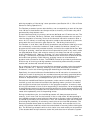
19-34 Vol. 3
ARCHITECTURE COMPATIBILITY
than 0DFFFH, the Intel486 processor will not wrap around and access incorrect loca-
tions within the TSS for I/O port validation and the P6 family and Pentium processors
will not experience general-protection exceptions (#GP). Figure 19-1 demonstrates
the different areas accessed by the Intel486 and the P6 family and Pentium
processors.
19.29 CACHE MANAGEMENT
The P6 family processors include two levels of internal caches: L1 (level 1) and L2
(level 2). The L1 cache is divided into an instruction cache and a data cache; the L2
cache is a general-purpose cache. See
Section 11.1, “Internal Caches, TLBs, and
Buffers,” for a description of these caches. (Note that although the Pentium II
processor L2 cache is physically located on a separate chip in the cassette, it is
considered an internal cache.)
The Pentium processor includes separate level 1 instruction and data caches. The
data cache supports a writeback (or alternatively write-through, on a line by line
basis) policy for memory updates.
The Intel486 processor includes a single level 1 cache for both instructions and data.
The meaning of the CD and NW flags in control register CR0 have been redefined for
the P6 family and Pentium processors. For these processors, the recommended value
(00B) enables writeback for the data cache of the Pentium processor and for the L1
Figure 19-1. I/O Map Base Address Differences
Intel486 Processor
FFFFH
I/O Map
Base Addres
FFFFH
FFFFH + 10H = FH
for I/O Validation
0H
FFFFH
FFFFH
I/O access at port 10H checks
0H
FFFFH + 10H = Outside Segment
for I/O Validation
bitmap at I/O address FFFFH + 10H,
which exceeds segment limit.
Wrap around does not occur,
general-protection exception (#GP)
I/O access at port 10H checks
bitmap at I/O map base address
FFFFH + 10H = offset 10H.
Offset FH from beginning of
TSS segment results because
P6 family and Pentium Processors
I/O Map
Base Addres
occurs. wraparound occurs.


















